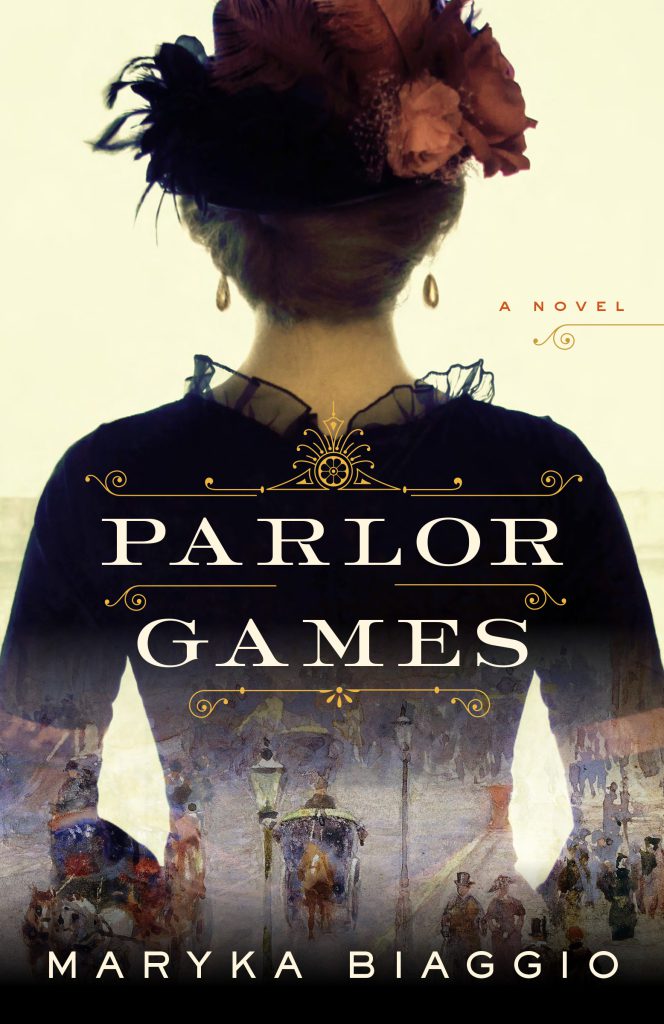
Buy the Book:
Bookshop (10% of sales go to indie bookstores)
Powell’s Books
Barnes & Noble
Amazon
Buy the audiobook:
Libro.fm
Amazon
Available in paperback, audio, and Kindle.
Parlor Games
Step into the seductive world of May Dugas, who uses charm and guile to ascend society's ranks—until a Pinkerton detective threatens to unravel her world.
It’s 1887, and eighteen-year-old May Dugas ventures to Chicago in hopes of earning enough money to support her family. But when circumstances force her to take up residence in the city’s most infamous bordello, she uses her feminine wiles to extract not only sidelong glances but large sums of money from the men she encounters. Insinuating herself into high society, May lands a well-to-do fiancé—until, that is, a Pinkerton detective named Reed Doherty intervenes.
Note: The film rights to Parlor Games have been sold.
Watch the book trailer:
Audiobook sample:
Praise for Parlor Games
“One of 12 Marvelous Novels about the Early 20th Century."
—Wiki.Ezvid
"Based on a true story, Biaggio re-creates the deliciously fabulous foibles and follies of a woman born into hardscrabble circumstances but determined to make her way in the world… Sheer, frenetic fun".
—Margaret Flanagan, Booklist Review
"Based on a true story, Biaggio’s narrative provides an engaging glimpse into a character who categorically eludes our attempts to define her.”
—Kirkus Reviews
“Like Becky Sharp from Vanity Fair before her, May Dugas—delightfully unrepentant—charms with tantalizing glimpses of her con games as she cheats her way from poverty into opulence.”
—Eva Stachniak, author of The Winter Palace
"Parlor Games is both playful and deeply serious in its portrayal of one determined woman's battle to make her way in a man's world. You'll be cheering for May Dugas as she cons her way across the continents. She's a terrific creation."
—Matt Rees, author of Mozart’s Last Aria
"Parlor Games is a captivating tale narrated by the irresistible and deliciously unreliable conwoman May Dugas. Her escapades, which span the Gilded Age right through the turn of the century, immediately transport the reader to a bygone era. It’s a wildly entertaining and constantly surprising ride."
—Daisy Goodwin, New York Times bestselling author of American Heiress
"Come meet May Dugas, a con artist of the highest order. You’ll be swept up by her delicious voice from the first page of Parlor Games, so prepare to be joyously fleeced. This jaunty tale through the life of a woman who keeps one step ahead of a dogged Pinkerton agent of the law is a true pleasure, something like munching your way through a box of chocolates all by yourself. Curl up, settle in for a lovely read."
—Kate Alcott, New York Times bestselling author of The Dressmaker
About the audio version:
“It's 1917, and May Dugas is on trial for extortion, but she's confident that she'll win the day. Her trial affords May the opportunity to reminisce about the love affairs and money-making schemes—often one and the same—she has had throughout her life. Narrator Leslie Carroll flawlessly captures May's charm, as well as her devil-may-care attitude. May is a compelling character, and Carroll makes her all the more so, while also doing a wonderful job of giving unique voices to the other characters—men and women alike. This story of Gilded Age schemes is delightfully fun, and Carroll's narration is the perfect complement.”
—J.L.K. Winner of AudioFile Earphones Award
Number One Book on the Goodreads List, Historical Fiction and Nonfiction Books That Should be Movies.
If you enjoyed Parlor Games, you might want to check out my recommendations for The Best Books About Wily, Take-Charge Women at Shepherd.com.
For Book Clubs: Reader’s Guide

One of May’s favorite haunts
Here are some questions that readers might like to ponder.
1. In the first paragraph May says, “You and I, my new friend, will become well acquainted over the course of this tale.” This suggests something more than the reader simply becoming acquainted with May. Why might the narrator address the reader like this in the opening chapter?
2. At the end of the first chapter May explains, “I will tell you my story—all of it—and truthfully, as I’ve never been able to tell anyone before.” Is she unerringly honest in recounting her story? What evidence is there of this one way or the other? What does this say about her stance toward the reader and her account of her story?
3. Does May provide a balanced account of the 1917 trial? What suggests that she does or does not?
4. What do Frank’s letters imply about the nature of the relationship between her and May? Can we trust Frank’s portrayal of her relationship with May? In what ways is Frank’s perspective on the trial different from May’s? What do the differences in their views tell us about May?
5. What kind of influence did May’s parents have on her? How would you characterize her father? Her mother? How important were her brothers to her?
6. Do you believe May loved any of the men she met during her travels? Did she ever find true love?
7. What does the yellow diamond necklace symbolize to May? What does it mean to you?
8. At one point the yellow diamond necklace goes missing. Do you think May knew of its whereabouts?
9. Early on, May refers to Pinkerton Detective Reed Dougherty as “the burr in my boot.” According to her telling, he is intruding on affairs he has no right to meddle in. Were his charges of blackmail, spying, and extortion justified, or was he, as May contends, interfering in personal matters outside the province of the law?
10. What might have motivated May to marry the Baron? Did the marriage start on firm footing or was it doomed to fail?
11. When speaking with Basil Zaharoff, May says, “I’ve never been able to determine what separates danger from adventure.” Is May a thrill seeker? Does she thrive on adventure? Can you think of instances in which she flirts with danger?
12. To what extent do you believe May’s actions were motivated by a desire to serve her family? And do you think May considers this a justification for her actions?
13. Did May learn anything over the course of her adventures and trials? If so, what lessons did she learn?
14. Did you cheer or jeer at the ending? (Remember: May did say, “You and I, my new friend, will become well acquainted over the course of this tale.”) At the close of the opening chapter, May exhorts the reader to hear her out and then be the judge. What is your verdict on May and her dealings with Frank and the men in her world?
Historical Fiction Research: Researching Parlor Games
 For historic pictures of May and the places she traveled, check out my Pinterest Board on Parlor Games.
For historic pictures of May and the places she traveled, check out my Pinterest Board on Parlor Games.
Parlor Games takes place in the late nineteenth and early-twentieth centuries, across wide-ranging locales—from small-town Michigan to New York City, Tokyo, London, and several European sites. The central character, May Dugas, was an adventurous woman who tangled with the Pinkertons while seeking wealth and the high life. So I had to research my protagonist, many locations, life at that period, and the Pinkerton Detectives.
My interest in May Dugas began with the discovery of journalist Lloyd Wendt’s Chicago Daily Tribune 1946-1947 series, “Most Dangerous Woman in the World.” Mr. Wendt’s account provided the broad outlines and many fascinating details of my protagonist’s life.
I conducted literature searches at and browsed collections of large public and university libraries for books on such topics as prostitution, blackmail, and the Chicago and San Francisco underworlds. As it turned out, many resources address these topics, and I had to sift through them to identify those that were most relevant. Some of the books I had to order via interlibrary loan. Others I could pull off the shelf and peruse before deciding whether they would inform my project. A number of them were so rich in information that I bought them, knowing they would be handy references. I read and skimmed many books, including scholarly works, historical accounts, monographs, novels, and writings from the period.
Photographs and films, both documentary and cinematic, were also very helpful. I was able to find some actual film footage of early 1900s New York, London, Shanghai, and Tokyo scenes. Such visual material is invaluable as an aid to scene construction. There is nothing like real-life shots of a place to stimulate the imagination and assist one in conjuring vibrant details.
Period newspapers were another rich source of information. They provided a sense of the language and tenor of the times, as well as detailed information about contemporary events and controversies. I obtained numerous articles from the Menominee Library about May Dugas’s coming and goings, as well as her Menominee trial. I also discovered newspaper accounts of her escapades in New York and London.
Language is a living and changing thing. To write about a different era, I needed to obtain a sense of how people talked and what words were and were not in usage. I read newspapers of the time and other contemporaneous sources. For verisimilitude, I added some words or phrases that were peculiar to the period.
I discovered a few books that provided information about the terminology of earlier periods:
- Maurine Harris and Glen Harris. Concise Genealogical Dictionary. Provo, UT: Ancestry, 1998.
- Paul Drake. What Did They Mean by That: A Dictionary of Historical Terms for Genealogists. Westminster, MD: Heritage Books, 1994.
Genealogy research, particularly vital records, was also a valuable source of historical detail. For my research, census records afforded a glimpse into the living conditions and backgrounds of people in the places my character lived.
Historical societies have voluminous resources: old maps, directories, and government documents. I interviewed the foremost expert on the life of May Dugas in Menominee, Janet Callow, who I tracked down through the Menominee Historical Society. I also spent a day at the New York Historical Society and found many helpful materials, including maps that showed street layouts in the early 1900s. Other local resources also served me well. For instance, I discovered that the New York City Library has a collection of genealogical and historical information on the city, as well as early photographs.
I found the internet most helpful for researching highly specific, obscure, or idiosyncratic topics, for instance, salaries and the costs of goods during the period, when hotels started offering room service, and what heating systems could be found in homes then. Of course, I checked on authorship of the material. Monographs or dissertations are more reliable sources of information than those developed by amateur historians.
I soon learned it is absolutely essential to take notes on key material and its source. After reading a few dozen books it was difficult to remember exactly what I had read in the first dozen. Also, since I often needed to revisit a particular source later for additional or clarifying information I found a good recording system indispensable.
The historical novelist will never (and should never) use all the facts gleaned, but to be really knowledgeable the writer must always acquire more information than he or she would ever actually use. Research was half the fun!